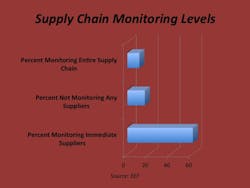A decade ago one of the hottest buzz-terms of the moment was “supply chain management.” The software in this category seemed poised to streamline manufacturing suppliers, assemblers and distributors in ways never dreamed of before. And then, seemingly overnight, the whole conversation about supply chain management was downsized into “warehouse management.”
My sense is that the shift occurred because the overarching ideas of supply chain management were put into play by enterprise software developers before many manufacturers had their warehouses in shape enough to play the global supply chain game.
Fast forward to today and it’s difficult not see how globalized the manufacturing supply chain has become — even for smaller manufacturers who now often find themselves an important part of a larger supply chain operation. As a matter of fact, the complexity of supply networks that have developed over the past two decades is what makes manufacturing so different from other parts of the economy. EEF, a U.K. based consultancy focused on manufacturing, says it best: “A sector that competes on providing custom solutions, quality and customer service, effective management of global value chains and dispersed customers is critical to maintaining a competitive advantage.”
Current reality
With supply chains co critical to modern manufacturing, EEF conducted a survey this year to get insight into supply chain structures and operation. Its survey shows that the average manufacturer has nearly 190 suppliers, and virtually all manufacturers have some of their supply base located overseas. The EEF report notes that, though the number and geographical spread of suppliers varies widely by company size and position in the supply chain, even smaller companies often depend on more than 100 suppliers of parts, components, and other services.
Despite the recent trend toward re-shoring, not all manufacturing operations are coming back. In the last two years, 30 percent of companies increased the number of overseas suppliers they used, compared with just 10 percent of companies who said they had reduced their use, according to the report. While this trend continues across companies of all sizes, it is interesting to note that mid-sized companies were the most likely to offshore, with 37 percent reporting increased use of international suppliers.
Disruptions
With geographically dispersed supply chains so clearly entrenched, natural disasters can wreak havoc on the delivery of goods. The notable disruptions in the automotive and electronic sectors as a result of the earthquake and tsunami in Japan and floods in Thailand have highlighted some of the problems inherent in complex and interdependent supply chains.
But disasters are not the only significant form of supply chain disruption for which manufacturers must be prepared. In its “Global Economic Risks” report (cited in the EEF study), the World Economic Forum states that the supply chain risks of greatest concern include:
• Major systemic financial failure — the picture may be clearing up now in the U.S., but some portions on the EU remain questionable;
• Energy and agriculture price volatility;
• The degree of specialization in some supply chains can also have big implications for companies when something goes wrong. Earlier in the year, a fire at a German chemical plant severely weakened an important link in automotive supply chains. The fire led to shortages of an important resin used in the manufacture of braking and fuel systems; and
• Regulatory change. The EU’s chemical regulation on the Registration, Evaluation and Authorization of Chemicals (REACH) is leading to some substances being withdrawn from the EU market with little pre-warning. In most cases this is because the costs of complying with REACH are greater than the commercial value of certain substances. However the effects on the downstream users of those chemicals can be significant.
Risk mitigation
Given these issues, what can manufacturers do to properly mitigate the risk of these events significantly impacting their ability to deliver product?
The EEF report says that the first step in managing supply chain risks is to develop a clear picture of the entire supplier ecosystem and put into place processes to systematically monitor capabilities and vulnerabilities. Using a collaborative supply chain partner agreement to closely monitoring the basic reporting capabilities of MES and SCADA systems throughout the supply chain, possibly coupled with key historian trend data, could go a long way toward addressing regular and real-time supply chain capability and vulnerability assessments.
For this to work, manufacturers will need to make great strides in the level of monitoring they currently do. According to EEF, only 11 percent of companies monitor their entire supply chains, with 60 percent only monitoring their immediate suppliers. Sixteen percent of companies said they did not monitor their suppliers at all.


